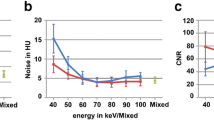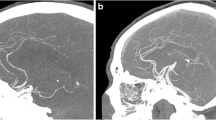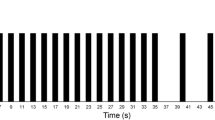Abstract
Introduction
Our aim was to examine the feasibility of a computed tomographic angiography (CTA) protocol using a reduced dose of high-concentration contrast material on a 16 multidetector-row system to visualize both cervical and cerebral arteries in one session.
Methods
In 31 consecutive patients, we performed CTA covering the cervical and cerebral arteries. The patients were assigned to one of three groups: group A, 100 mL of 300 mgI/mL; group B, 80 mL of 370 mgI/mL; and group C, 60 mL of 370 mgI/mL followed by a 30-mL saline flush. Arterial enhancements were quantified by measuring attenuation values of the common carotid artery, internal jugular vein, proximal middle cerebral artery (MCA), basilar artery, and straight sinus on source images. Visualizations of the carotid bifurcation and arteries continuing to the circle of Willis were rated on a three-point grading scale on CTA images for qualitative assessment.
Results
There were no statistically significant differences in attenuation of all the target vessels among the three groups, with the one exception being a lower attenuation of the MCA in group C than in groups A and B (P < 0.01). Neither were there any significant differences noted among the three groups on the visual assessment.
Conclusion
Use of a reduced dose of high iodine concentration contrast material may provide an equal degree of image quality for CTA covering the craniocervical region on a 16 multidetector-row system.


Similar content being viewed by others
References
Chen CJ, Lee TH, Hsu HL et al (2004) Multi-slice CT angiography in diagnosing total versus near occlusions of the internal carotid artery: comparison with catheter angiography. Stroke 35:83–85
Koelemay MJW, Nederkoorn PJ, Reitsma JB et al (2004) Systematic review of computed tomographic angiography for assessment of carotid artery disease. Stroke 35:2306–2312
Villablanca JP, Jahan R, Hooshi P et al (2002) Detection and characterization of very small cerebral aneurysms by using 2D and 3D helical CT angiography. AJNR Am J Neuroradiol 23:1187–1198
Wintermark M, Uske A, Chalaron M et al (2003) Multislice computerized tomography angiography in the evaluation of intracranial aneurysms: a comparison with intraarterial digital subtraction angiography. J Neurosurg 98:828–836
Silverman PM, Brown B, Wray H et al (1995) Optimal contrast enhancement of the liver using helical (spiral) CT: value of Smart-Prep. AJR Am J Roentgenol 164:1169–1171
Birnbaum BA, Jacobs JE, Yin D et al (1995) Hepatic enhancement during helical CT: a comparison of moderate rate uniphasic and biphasic contrast injection protocols. AJR Am J Roentgenol 165:853–858
Brink JA, Heiken JP, Forman HP et al (1995) Hepatic spiral CT: reduction of dose of intravenous contrast material. Radiology 197:83–88
Herts BR, Paushter DM, Einstein DM et al (1995) Use of contrast material for spiral CT of the abdomen: comparison of hepatic enhancement and vascular attenuation for three different contrast media at two different delay times. AJR Am J Roentgenol 164:327–331
Fleischmann D (2003) High-concentration contrast media in MDCT angiography: principles and rationale. Eur Radiol 13(Suppl. 3):N39–N43
Fleischmann D (2005) How to design injection protocols for multiple detector-row CT angiography (MDCTA). Eur Radiol 15(Suppl. 5):E60–E65
Herman S (2004) Computed tomography contrast enhancement principles and the use of high-concentration contrast media. J Comput Assist Tomogr 28(Suppl 1):S7–S11
Hopper KD, Mosher TJ, Kasales CJ et al (1997) Thoracic spiral CT: delivery of contrast material pushed with injectable saline solution in a power injector. Radiology 205:269–271
Haage P, Schmitz-Rode T, Hubner D et al (2000) Reduction of contrast material dose and artifacts by a saline flush using a double power injector in helical CT of the thorax. AJR Am J Roentgenol 174:1049–1053
Setty BN, Sahani DV, Ouellette-Piazzo K et al (2006) Comparison of enhancement, image quality, cost, and adverse reactions using 2 different contrast medium concentrations for routine chest CT on 16-slice MDCT. J Comput Assist Tomogr 30:818–822
Schuknecht B (2007) High-concentration contrast media (HCCM) in CT angiography of the carotid system: impact on therapeutic decision making. Neuroradiology 49(Suppl. 1):S15–S26
Lell M, Fellner C, Baum U et al (2007) Evaluation of carotid artery stenosis with multisection CT and MR imaging: Influence of imaging modality and postprocessing. AJNR Am J Neuroradiol 28:104–110
Conflict of interest statement
We declare that we have no conflict of interest.
Author information
Authors and Affiliations
Corresponding author
Rights and permissions
About this article
Cite this article
Fujikawa, A., Tsuchiya, K., Imai, M. et al. CT angiography covering both cervical and cerebral arteries using high iodine concentration contrast material with dose reduction on a 16 multidetector-row system. Neuroradiology 52, 291–295 (2010). https://doi.org/10.1007/s00234-009-0611-y
Received:
Accepted:
Published:
Issue Date:
DOI: https://doi.org/10.1007/s00234-009-0611-y




